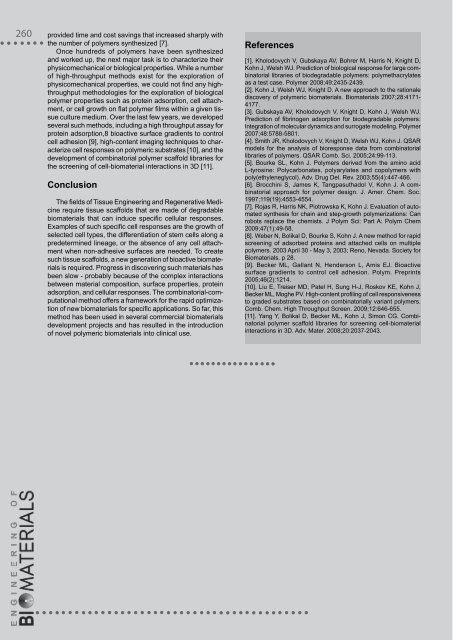89-91 - Polskie Stowarzyszenie Biomateriałów
89-91 - Polskie Stowarzyszenie Biomateriałów
89-91 - Polskie Stowarzyszenie Biomateriałów
You also want an ePaper? Increase the reach of your titles
YUMPU automatically turns print PDFs into web optimized ePapers that Google loves.
260 provided time and cost savings that increased sharply with<br />
the number of polymers synthesized [7].<br />
Once hundreds of polymers have been synthesized<br />
and worked up, the next major task is to characterize their<br />
physicomechanical or biological properties. While a number<br />
of high-throughput methods exist for the exploration of<br />
physicomechanical properties, we could not find any highthroughput<br />
methodologies for the exploration of biological<br />
polymer properties such as protein adsorption, cell attachment,<br />
or cell growth on flat polymer films within a given tissue<br />
culture medium. Over the last few years, we developed<br />
several such methods, including a high throughput assay for<br />
protein adsorption,8 bioactive surface gradients to control<br />
cell adhesion [9], high-content imaging techniques to characterize<br />
cell responses on polymeric substrates [10], and the<br />
development of combinatorial polymer scaffold libraries for<br />
the screening of cell-biomaterial interactions in 3D [11].<br />
conclusion<br />
The fields of Tissue Engineering and Regenerative Medicine<br />
require tissue scaffolds that are made of degradable<br />
biomaterials that can induce specific cellular responses.<br />
Examples of such specific cell responses are the growth of<br />
selected cell types, the differentiation of stem cells along a<br />
predetermined lineage, or the absence of any cell attachment<br />
when non-adhesive surfaces are needed. To create<br />
such tissue scaffolds, a new generation of bioactive biomaterials<br />
is required. Progress in discovering such materials has<br />
been slow - probably because of the complex interactions<br />
between material composition, surface properties, protein<br />
adsorption, and cellular responses. The combinatorial-computational<br />
method offers a framework for the rapid optimization<br />
of new biomaterials for specific applications. So far, this<br />
method has been used in several commercial biomaterials<br />
development projects and has resulted in the introduction<br />
of novel polymeric biomaterials into clinical use.<br />
references<br />
[1]. kholodovych V, Gubskaya AV, Bohrer M, Harris N, knight D,<br />
kohn J, Welsh WJ. Prediction of biological response for large combinatorial<br />
libraries of biodegradable polymers: polymethacrylates<br />
as a test case. Polymer 2008;49:2435-2439.<br />
[2]. kohn J, Welsh WJ, knight D. A new approach to the rationale<br />
discovery of polymeric biomaterials. Biomaterials 2007;28:4171-<br />
4177.<br />
[3]. Gubskaya AV, kholodovych V, knight D, kohn J, Welsh WJ.<br />
Prediction of fibrinogen adsorption for biodegradable polymers:<br />
Integration of molecular dynamics and surrogate modeling. Polymer<br />
2007;48:5788-5801.<br />
[4]. Smith JR, kholodovych V, knight D, Welsh WJ, kohn J. QSAR<br />
models for the analysis of bioresponse data from combinatorial<br />
libraries of polymers. QSAR Comb. Sci. 2005;24:99-113.<br />
[5]. Bourke SL, kohn J. Polymers derived from the amino acid<br />
L-tyrosine: Polycarbonates, polyarylates and copolymers with<br />
poly(ethyleneglycol). Adv. Drug Del. Rev. 2003;55(4):447-466.<br />
[6]. Brocchini S, James k, Tangpasuthadol V, kohn J. A combinatorial<br />
approach for polymer design. J. Amer. Chem. Soc.<br />
1997;119(19):4553-4554.<br />
[7]. Rojas R, Harris Nk, Piotrowska k, kohn J. Evaluation of automated<br />
synthesis for chain and step-growth polymerizations: Can<br />
robots replace the chemists. J Polym Sci: Part A: Polym Chem<br />
2009;47(1):49-58.<br />
[8]. Weber N, Bolikal D, Bourke S, kohn J. A new method for rapid<br />
screening of adsorbed proteins and attached cells on multiple<br />
polymers. 2003 April 30 - May 3, 2003; Reno, Nevada. Society for<br />
Biomaterials. p 28.<br />
[9]. Becker ML, Gallant N, Henderson L, Amis EJ. Bioactive<br />
surface gradients to control cell adhesion. Polym. Preprints<br />
2005;46(2):1214.<br />
[10]. Liu E, Treiser MD, Patel H, Sung H-J, Roskov kE, kohn J,<br />
Becker ML, Moghe PV. High-content profiling of cell responsiveness<br />
to graded substrates based on combinatorially variant polymers.<br />
Comb. Chem. High Throughput Screen. 2009;12:646-655.<br />
[11]. yang y, Bolikal D, Becker ML, kohn J, Simon CG. Combinatorial<br />
polymer scaffold libraries for screening cell-biomaterial<br />
interactions in 3D. Adv. Mater. 2008;20:2037-2043.













